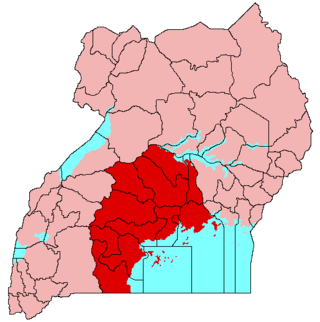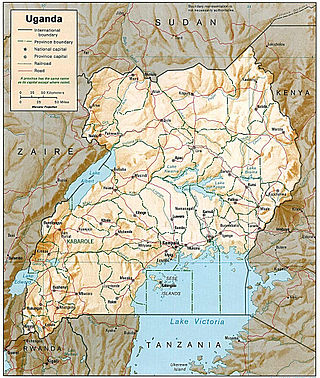This article includes a list of references, related reading, or external links, but its sources remain unclear because it lacks inline citations .(August 2020) |
Ggulu is a translation for heaven in the Bantu language Luganda.
This article includes a list of references, related reading, or external links, but its sources remain unclear because it lacks inline citations .(August 2020) |
Ggulu is a translation for heaven in the Bantu language Luganda.
In the legend, two of Ggulu's daughters discover Kintu, the first human being according to Gandan myth. When Kintu declines to follow the daughters to heaven, they tell Ggulu who promptly tells his son to steal Kintu's cow, his only source of nutrition. When Kintu is brought to heaven by Nambi, Ggulu's daughter, Ggulu tests him by ordering Kintu to eat ten thousand meals to prove that he is a man. Kintu secretly disposes of the food into a hidden cavern and Ggulu tests him yet again. When Kintu succeeds in the second test of cutting stones through the use of a magical bronze axe, Ggulu orders Kintu to fetch him a bucket of dew to drink. Kintu is able to do this as the bucket itself has magical powers. Ggulu then tests Kintu one final time by herding three herds of ten thousand of cows before him. Kintu's job is to retrieve his cow and when the third herd is driven by, a magic hornet aids him in identifying his cow and two calves born while in captivity.
Upon passing all of Ggulu's tests, Ggulu gives Kintu his daughter, Nambi, to take back to Earth. He also gives them multiple vegetable plants, a hen, and some millet. He warns them then to hurry back to Earth to avoid gaining the attention of Walumbe (meaning "disease or death"), Nambi's brother. He tells them not to come back for anything, but when Kintu forgets the hen's millet, he returns for it. Upon Kintu's return, Walumbe discovers the situation and confronts Kintu and Nambi. After much deliberation, Kintu and Nambi allow Walumbe to stay with them on Earth for a time. When Walumbe begins killing children on Earth, Kintu returns to Ggulu. Ggulu sends his son, Kayiikuuzi, to aid in ridding Earth of Walumbe. Finally, when humans ruin Kayiikuuzi's plan for capturing Walumbe, Kayiikuuzi returns to heaven and Ggulu allows Walumbe to remain on Earth.

The Monkey King or Sun Wukong is a fictional character best known as one of the main players in the 16th-century Chinese novel Journey to the West, and many later stories and adaptations. In the novel, Sun Wukong is a monkey born from a stone who acquires supernatural powers through Taoist practices. After rebelling against heaven, he is imprisoned under a mountain by the Buddha. After five hundred years, he accompanies the monk Tang Sanzang (唐三藏) riding on the White Dragon Horse and two other disciples, Zhu Bajie and Sha Wujing, on a journey to obtain Buddhist sutras from the West (India), where Buddha and his followers dwell.

Kullervo is an ill-fated character in the Kalevala, the Finnish national epic compiled by Elias Lönnrot.

Buganda is a Bantu kingdom within Uganda. The kingdom of the Baganda people, Buganda is the largest of the traditional kingdoms in present-day East Africa, consisting of Buganda's Central Region, including the Ugandan capital Kampala. The 14 million Baganda make up the largest Ugandan region, representing approximately 16% of Uganda's population.
Zauriel is a fictional superhero in the DC Universe. Originally a guardian angel who served Heaven for millions of years, he willingly falls to Earth to serve humanity as their champion and joins the Justice League.

Bunyoro, also called Bunyoro-Kitara, is a Bantu kingdom in Western Uganda. It was one of the most powerful kingdoms in Central and East Africa from the 13th century to the 19th century. It is ruled by the King (Omukama) of Bunyoro-Kitara. The current ruler is Solomon Iguru I, the 27th Omukama.

Bees have been featured in myth and folklore around the world. Honey and beeswax have been important resources for humans since at least the Mesolithic period, and as a result humans' relationship with bees—particularly honey bees—has ranged from encounters with wild bees to keeping them agriculturally. Bees themselves are often characterized as magically-imbued creatures, and their honey as a divine gift.

The Book of the Dun Cow (1978) is a fantasy novel by Walter Wangerin Jr. It is loosely based upon the beast fable of Chanticleer and the Fox adapted from the story of "The Nun's Priest's Tale" from Geoffrey Chaucer's Canterbury Tales. It has two sequels.
Kintu is a mythological figure who appears in a creation myth of the people of Buganda, Uganda. According to this legend, Kintu was the first person on earth.
Warumbe or Walumbe is a character in the Ganda creation myth, the legend of Kintu. He is the son of Ggulu and the brother of Nambi. His name in the Luganda language means 'disease' or 'death' and he is responsible for death on Earth according to Gandan mythology.
Kaikuzi or Kayikuuzi is a character in the Gandan creation myth, The Legend of Kintu. He is the son of Ggulu. His name is translated as "the digger." He is responsible for attempting to rid the Earth of Walumbe, meaning "death" or "disease."

Castiel is a fictional character portrayed by Misha Collins on The CW's American fantasy television series Supernatural. An Angel of the Lord, he first appears in the fourth season and is used to introduce the theme of Christian theology to the series. In the series, Castiel brings Dean Winchester back from Hell and frequently helps him and his brother, Sam, in their battles with various demons and angels along the way. During his travels with the Winchesters, Castiel develops friendships with both men. As an angel, he possesses a number of supernatural abilities, including the ability to kill demons. Initially, the character demonstrates complete devotion to God and little emotion. However, his interactions and experiences with Dean and Sam, as well as certain revelations about God and his fellow angels, have a humanizing effect on him. This, despite the stress and harm it causes his character, allows him to develop an independent will as the series progresses and helps the show address topics related to free will.

The mythology of Indonesia is very diverse, the Indonesian people consisting of hundreds of ethnic groups, each with their own myths and legends that explain the origin of their people, the tales of their ancestors and the demons or deities in their belief systems. The tendency to syncretize by overlying older traditions with newer foreign ideas has occurred. For example, the older ancestral mythology might be merged with foreign mythology, such as Hindu, Islam, or Christian biblical mythology.

Wawacan Sulanjana is a Sundanese manuscript containing Sundanese myths. The title means "The Tale of Sulanjana", derived from the name of the hero Sulanjana as the protector of rice plant against the attack of Sapi Gumarang cow, Kalabuat and Budug Basu boars symbolizing rice pestilence. The Wawacan Sulanjana contains Sundanese local wisdom through reverence of rice cultivation in its tradition.
Tulisa, the Wood-Cutter's Daughter is an Indian legend published as an annex to Somadeva Bhaṭṭa's work, related to Cupid and Psyche.

Insects have appeared in mythology around the world from ancient times. Among the insect groups featuring in myths are the bee, fly, butterfly, cicada, dragonfly, praying mantis and scarab beetle.

Nambi is the daughter of Mugulu, also known as Ggulu in some versions of Baganda mythology. In the Ugandan creation myth, it is Nambi and her younger sister who discover Kintu, the first man. Nambi helps Kintu throughout his journey and trials, and eventually becomes his wife and mother of his children.
The Seng-gut narrative is a Korean shamanic narrative traditionally recited in a large-scale gut ritual in Hamgyong Province, North Korea. It tells of the deeds of one or multiple deities referred to as "sages," beginning from the creation of the world. It combines many stories that appear independently in other regions of Korea into a single extended narrative. In the first story, the deity Seokga usurps the world from the creator, creates animals from deer meat, and destroys a superfluous sun and moon. In the second, the carpenter Gangbangdek builds a palace for the gods, loses a wager to a woman, and becomes the god of the household. In the third and fourth stories, a boy who does not talk until the age of ten becomes the founder of a new Buddhist temple and melts a baby into iron to forge a temple bell. In the fifth, the same priest destroys a rich man for having abused him. Finally, the priest makes his three sons the gods of fertility, ending the story. The narrative has a strong Buddhist influence.
Khastakhumār and Bībīnagār or Xasteh Xomār is an Afghan folktale. Both titles refer to tales related to the international cycle of the Animal as Bridegroom or The Search for the Lost Husband: a human maiden is married to an enchanted prince in snake form, loses him, and has to search for him. According to scholarship, other variants are known in Afghanistan.
The Tale about Baba-Yaga is a Russian fairy tale first published in a late 18th-century compilation of fairy tales.

Ugandan folklore includes traditional folktales and other folklore from the African country of Uganda. The convey meaning and experiences from generation to generation. Traditionally, folktales instilled discipline and good behaviour that shaped societal beliefs and norms within Ugandan society.